Menu
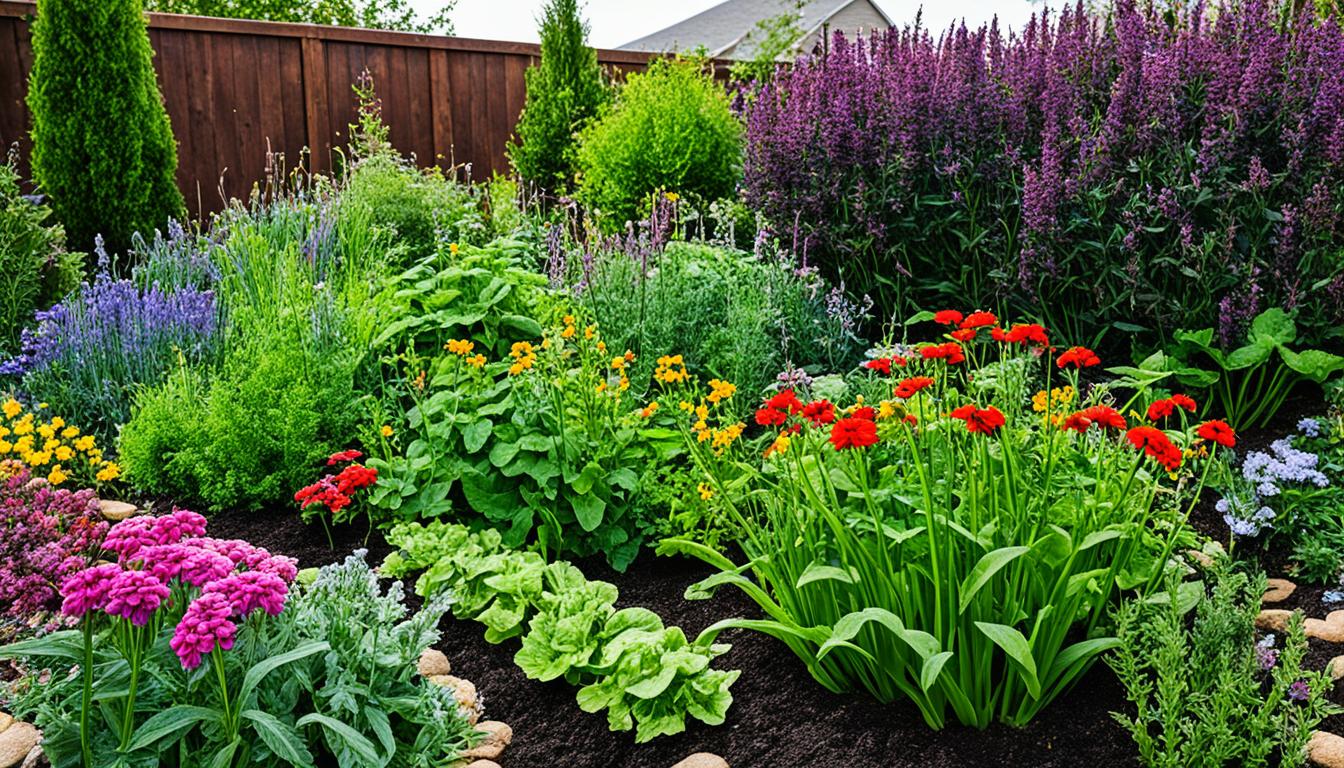
Healthy soil is key in organic gardening for reducing disease risks. Pest experts say using Integrated Pest Management (IPM) can control bugs in eco-friendly ways. Aimee Ladonski and Wyatt Brown say by focusing on healthy soils full of microbes, we tackle pests from the ground up.
But, a good pest plan in organic gardening needs more. It must deal with all the things that stress plants, keeping them healthy. This means using many tactics together.
Organic pest control focuses on non-toxic ways to handle pests. It uses methods like natural controls and avoids using harmful chemicals. The aim is to protect the environment while keeping pests under control.
By using natural pest repellents, it makes the environment safer for butterflies, bees, and ladybirds. This approach is chemical-free, reducing harm to the ecosystem.
However, going organic can be more expensive. *Organic pesticides cost more* than regular ones. This can make it hard for everyone to use them. It also needs more knowledge and careful timing to work well.
Synthetic pesticides work fast and last long but they can harm the earth and good insects. Organic methods take longer to see results. Yet, they are better for the earth and support healthy soil.
Organic pest control uses many strategies. Methods like Integrated Pest Management (IPM) mix organic thinking with smarter pest control. This way, we can fight pests without harming the ecosystem.
Healthy soil and diverse plant life are key to stopping pests from the start. By making our gardens friendlier to plants and bugs, we can keep pests away naturally. This makes for a greener and healthier way to care for our gardens.
Organic pest control is great for gardens and homes. It works well and it’s safe for the planet and people. In the long term, it can save you money too.
By using organic methods, we protect the environment. Chemicals can harm soil and water. Earth-friendly products help keep the ecosystem healthy by not killing good bugs and microorganisms.
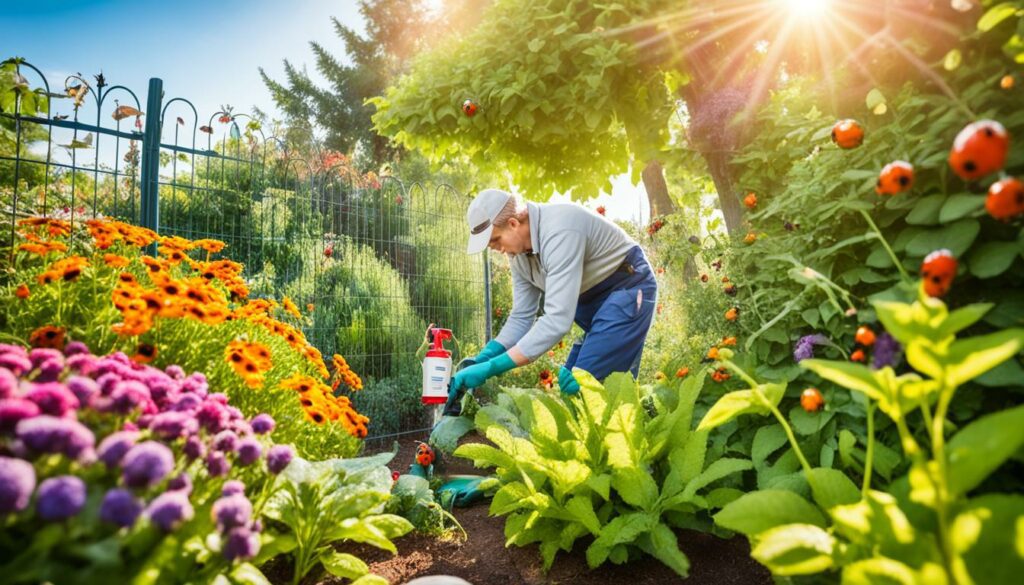
Also, organic methods stop pests getting stronger against treatments. It means they keep working well over time.
Choosing organic pest control is good for health. Chemicals can hurt humans and animals. But organics are safe for kids, pets, and the environment.
Diatomaceous earth is safe and effective on pests. The EPA says organic pest control is best for health.
At first, organic pest control might cost more. But in the long run, it’s often cheaper than chemicals. It’s because you don’t need to use as much or as often.
Organics also keep your garden healthier. So, you spend less on fixing soil and plants later.
| Aspect | Organic Pest Control | Chemical Pest Control |
|---|---|---|
| Environmental Impact | Low | High |
| Health Risk | Minimal | Significant |
| Effectiveness Duration | Longer | Shorter |
| Cost Over Time | Potentially Lower | Potentially Higher |
Integrated Pest Management (IPM) is a smart way to keep pests in check. It uses environment-friendly ways to stop pests from spreading. IPM addresses pests through various cultural, biological, and structural means, avoiding chemicals. It puts a big focus on stopping pest issues even before they start. This means knowing the pests and how they live.
IPM wards off many pest types without using harmful chemicals. It encourages helpful wildlife to fight pests. For instance, you can improve your garden for spiders and pollinators. Also, inviting predators like certain bugs and ladybirds helps keep the balance. This way, they eat harmful bugs and keep plants healthy.
To keep pests away, IPM might use things that scare them or food they don’t like. By learning when pests are most active, these methods work better. The usual way to deal with pests is to spray pesticides often. But IPM avoids this, using chemicals only when it’s really needed.
IPM’s methods are not-harmful to the environment and people. It includes letting plants defend themselves, using certain cultural practices, and even helpful bugs. Following a pyramid of methods, IPM starts with safe strategies. It turns to chemicals as a last resort, and aims to pick the best for the environment. This way, it protects everyone.
Learning about pests and their foes is key to doing IPM right. Guides like the Virginia Cooperative Extension’s IPM Guide can help with this. IPM needs you to know your pests well, from diseases to insects. By balancing safe and chemical ways, IPM keeps pests away in the best way possible.
Keeping the soil healthy is the first step for good pest control without chemicals. Good soil helps plants fight off bugs. It’s important to know what makes soil strong and healthy.
Rich soil is key for healthy plants that don’t need artificial pest killers. The right kind of soil, called loam, helps plants get the water they need. Adding stuff like compost to soil makes it better for growing. It helps plants get more nutrients and water.
The right soil acidity is also very important. It helps plants take in nutrients well. Different plants like different levels of acidity, which can help keep pests away. Moist soil is needed too. It helps plants grow well and there are more friendly bugs that help control pests in moist soil.
Things like changing the crop and planting things between them can make the soil more alive and diverse. This makes it a good place for helpful organisms. They help control pests in a natural way. Also, not disturbing the soil much and keeping it covered helps keep the good life in the soil.
Small life in the soil, like bacteria and worms, are very important for fighting off pests. They eat dead stuff and help plants get nutrients. This makes the plants stronger against pests.
“Soil health is bedrock to sustainable agriculture,” says Dr. Elaine Ingham, a renowned soil microbiologist. Understanding microbial processes is central to enhancing soil fertility and managing pests organically.
Healthy soils with lots of life can stop many diseases attacking plants. The area around plant roots, the rhizosphere, is vital for plant food and health. Microbes that live there also stop pests because they help the plant.
Doing things like not digging much and using things like compost can make soil very alive. This is very good for plants and can control pests without bad chemicals.
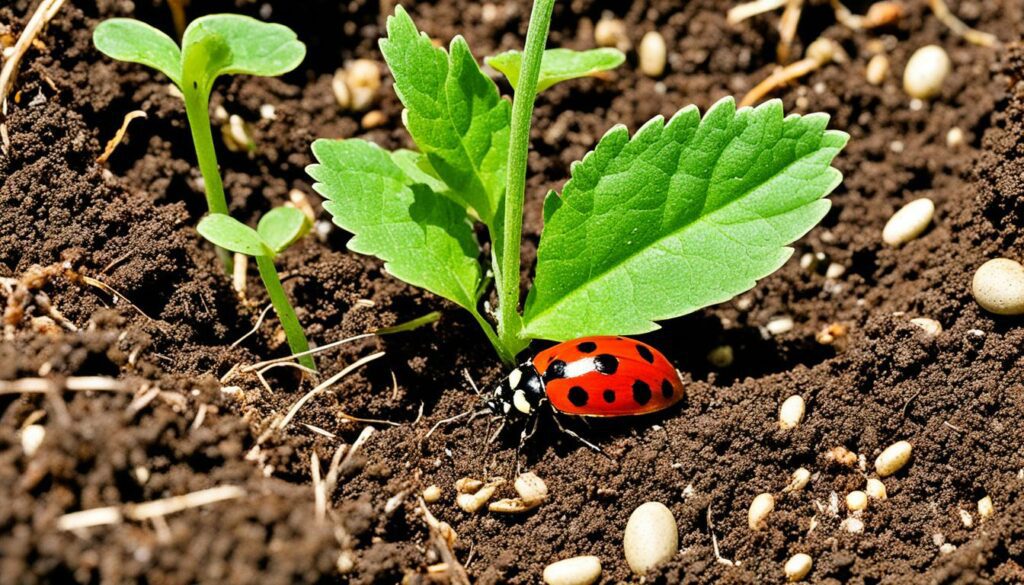
| Soil Component | Function | Impact on Pest Control |
|---|---|---|
| Soil Texture | Optimal drainage and aeration | Reduces pest habitat suitability |
| Soil Organic Matter | Improves nutrient and moisture retention | Enhances plant health, deterring pests |
| Soil pH | Facilitates nutrient uptake | Boosts overall plant resilience |
| Microbial Activity | Nutrient cycling and organic matter decomposition | Suppresses pathogen activity |
| Biodiversity | Supports a range of beneficial organisms | Natural pest suppression through ecosystem balance |
In organic gardening, cultural control methods are key. They include things like planting certain plants together, changing where crops grow each year, and carefully picking what plants to grow. These methods make the garden a place where pests and diseases find it hard to thrive. By using these approaches, we not only keep pests in check but also help the garden’s ecosystem stay healthy.
Growing certain plants together can protect them from pests and help them grow better. For example, planting marigolds near tomatoes keeps harmful worms away. Growing basil close by helps to ward off flies. By doing this, we use plants’ natural abilities to protect themselves, helping the whole garden stay strong.
Changing where we grow different crops each year is very helpful. It helps the soil stay healthy and prevents pests from getting too comfortable. For example, after growing beans in a spot for a year, moving them somewhere else can improve the soil. This also stops pests from finding the same plants year after year, which can reduce pest problems.
Choosing the right plants that thrive in the local area and are naturally resistant to pests is crucial. This choice helps in lowering the number of pests in the garden. It works like a natural shield, keeping the garden healthy without needing as many chemical sprays.
| Method | Benefits | Examples |
|---|---|---|
| Companion Planting | Deters pests, enhances growth | Marigolds with tomatoes, basil with flies |
| Crop Rotation | Reduces soil depletion, lowers pest buildup | Legumes followed by other crops |
| Selection of Plant Species | Increases resistance, improves garden health | Native, pest-resistant varieties |
Mechanical and physical controls are key in fighting pests, part of Integrated Pest Management. They use barriers and devices to protect plants from harm. This includes screens, barriers, traps, and mulches to keep pests away.
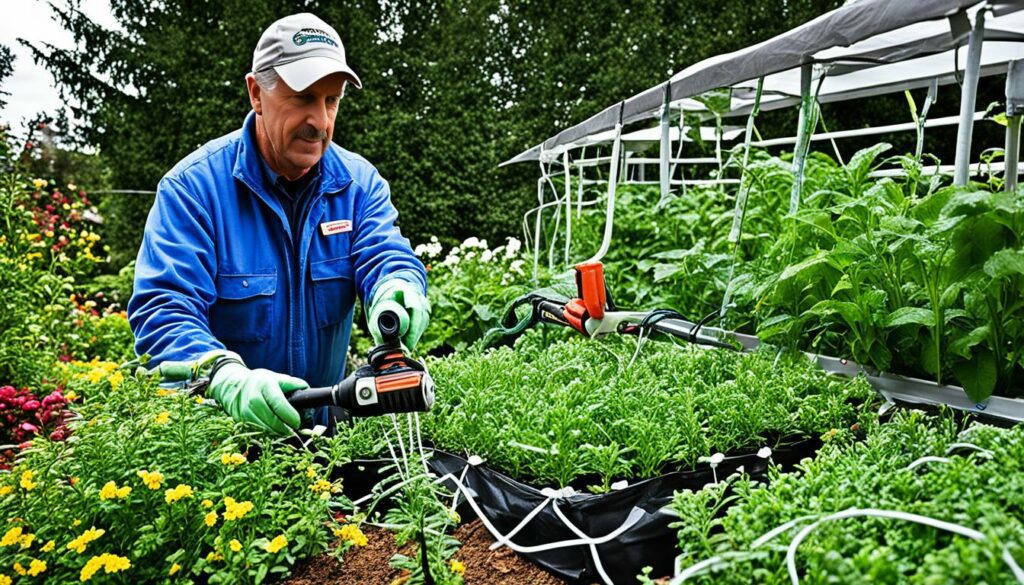
Deer fences, chicken wire, and insect screens are great at keeping pests out. They make it hard for pests to get to the plants. Bird nets and shade cloths also help, protecting different types of crops. Floating row covers are good for protecting plants that grow close to the ground.
Traps are another important part of keeping pests controlled. From sticky ones to pheromone and light traps, they all have their jobs. Yellow sticky traps, for instance, are really good at catching aphids, thrips, whiteflies, and fungus gnats.
Mechanical and physical ways stop pests quickly and without hurting other helpful creatures. Using these methods, we can lower the number of pests without using chemicals.
| Control Method | Description | Target Pest |
|---|---|---|
| Deer Fences | Physical barriers designed to keep deer away from crops. | Deer |
| Chicken Wire | Mesh fencing used to prevent small animals from accessing the garden. | Rabbits, Small Mammals |
| Insect Screens | Fine mesh used to block insects from entering greenhouses or enclosures. | Insects |
| Bird Nets | Netting placed over trees or crops to prevent bird damage. | Birds |
| Sticky Traps | Adhesive traps that capture flying insects upon contact. | Aphids, Thrips, Whiteflies, Fungus Gnats |
| Pheromone Traps | Traps using pheromones to lure and capture specific insect species. | Apple Codling Moth |
Using living organisms to control pests is a key part of pest management. It helps keep the pest numbers low. This method works by creating a balanced ecosystem with natural checks and balances.
Insects like lady beetles and lacewings are vital. They are called ‘Generalists’ because they eat many kinds of pests. ‘Specialists,’ on the other hand, focus on one pest type, like parasitic wasps.
Natural predators are critical in pest control. For example, decapitating flies help fight fire ants. Beetles and similar bugs work against alligator weed. Introducing them can greatly reduce pest issues for the long term without harming the environment.
Growing different plants can help keep pests under control. This method increases the number of natural predator homes. It attracts more beneficial insects and makes the whole environment stronger.
| Control Type | Description | Example |
|---|---|---|
| Classical Biological Control | This method uses enemies from pests’ home areas to control them. | Decapitating flies against red imported fire ants. |
| Augmentative Biological Control | It involves releasing more control agents if nature’s balance needs help. | Done in places like greenhouses and nurseries. |
| Conservation Biological Control | Diverse planting and care to keep natural pest enemies around. | Creating many types of plant communities. |
Using beneficial insects and growing many plants can improve pest control. It supports a system where natural predators help keep pest numbers low. This is a more sustainable and eco-friendly way of managing pests.
Trying out natural pest repellent methods in your garden can really help. It makes the environment healthier and more stable. Chemical pesticides can hurt good bugs and make soil and water dirty. But, natural sprays and treatments work well and are safe for people and the planet.
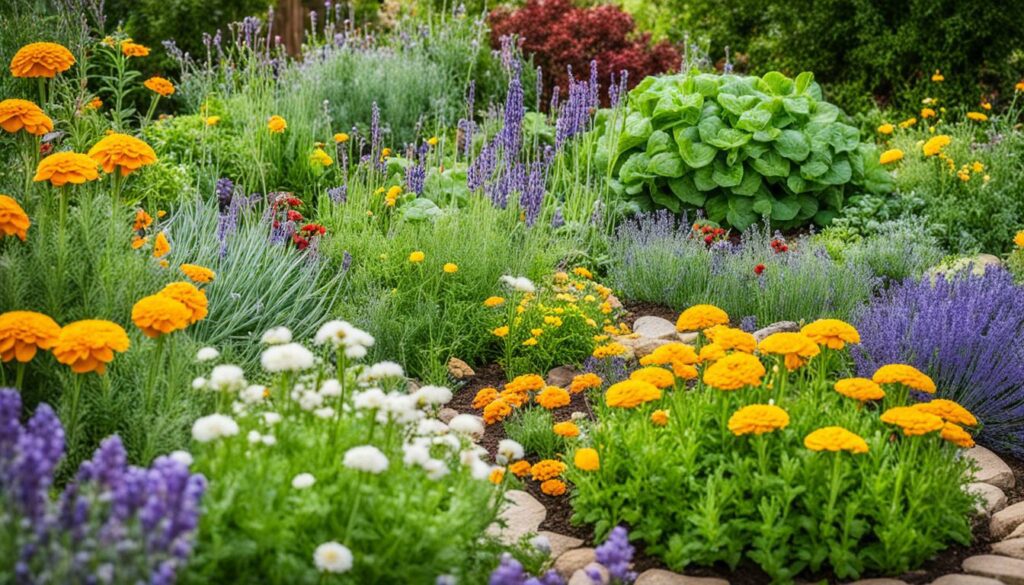
There are big benefits to natural garden pest control. It deals with just the bad bugs, keeping good insects safe. This helps keep your garden’s ecosystem in balance. Plus, it means you won’t eat foods with harmful chemicals on them. Using natural methods is also better for the long run. This is because pests don’t usually get used to them like they do with chemicals.
There are many ways to use natural pest repellent methods in your garden. You can plant flowers or herbs like marigolds and alliums. These naturally keep pests away. Making your own remedies from simple things like garlic or chili can also work. These steps keep dangerous chemicals out of your garden, which helps the earth and keeps people safe.
So, using natural pest repellent methods and organic deterrents is great. It helps keep your garden and our planet healthy. But, you need to check and catch any pest problems early. This allows you to fix things without using bad chemicals. And that’s a win for everyone.
Neem oil is from the seeds of the neem tree, found in tropical areas. It’s great for organic gardening as it tackles pests and is safe for the environment. Azadirachtin is its key element, keeping bugs away and killing them. It’s very good against whitefly, aphids, Japanese beetles, and many more.
Neem oil is very safe. It breaks down easily in soil, water, and leaves, which helps the environment. This feature makes it a choice for both organic and environmentally friendly pest control.
Nigel Taylor, an expert in organic treatments, states, “Neem oil not only acts as an insecticide but also serves as a fungicide, combating plant diseases such as rust, black spot, mildew, leaf spot, scab, anthracnose, blight, and botrytis.”
To use neem oil, mix 1 to 2 tablespoons with a gallon of water and a bit of dish soap. Spray this on your plants every week for best results against pests. It’s also used in over one hundred pesticides, coming in different forms.
The active part of neem oil, azadirachtin, breaks down fast. It is gone from soil in 3 to 44 days, from water in 48 minutes to 4 days, and from leaves in 1-2.5 days. This quick breakdown means it doesn’t harm the environment much. Birds, mammals, and bees are safe, but fish might have a small risk.
| Pest Control Aspect | Details |
|---|---|
| Active Ingredient | Azadirachtin |
| Effectiveness | Controls hundreds of pests; serves as a fungicide |
| Environmental Impact | Breaks down quickly; safe for non-target species |
| Application Frequency | Every seven days |
| Forms | Granules, Dust, Wettable Powders, Emulsifiable Concentrates |
In summary, neem oil is vital for safe and effective pest control in organic approaches. It avoids the harm that synthetic pesticides can cause.
Since the 1950s, farmers have been using Bacillus thuringiensis (Bt) to control pests. It was first sold in the United States in 1958. Bt is key to eco-friendly pest control because it only kills harmful bugs, not the good ones.
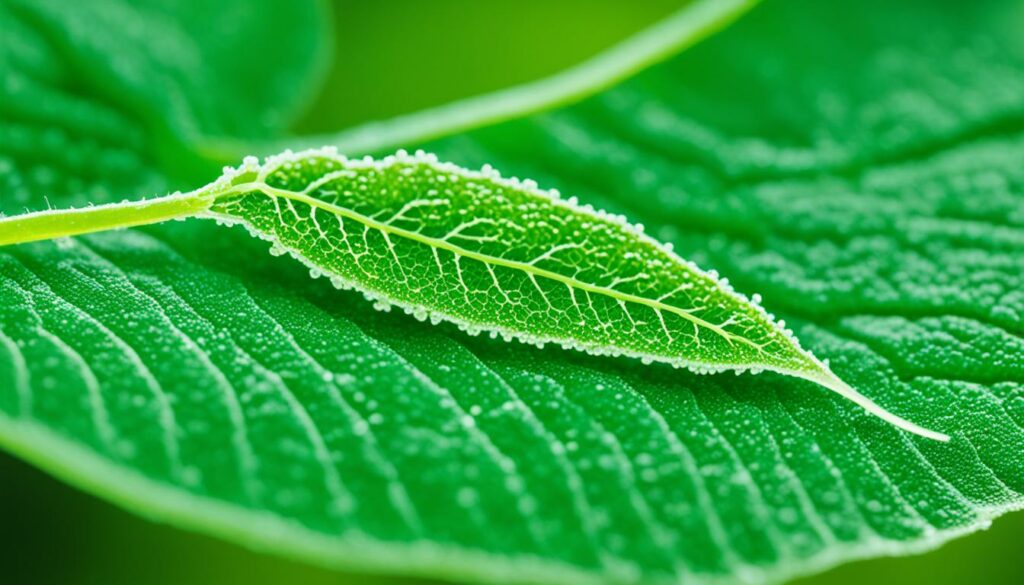
Bacillus thuringiensis is perfect for certain types of bugs. There are several kinds of Bt, each targeting different pests:
Bt mainly goes after certain insects types, like butterflies and beetles. This helps prevent harm to helpful insects.
Using Bacillus thuringiensis requires good timing for best results. You can find Bt in dusts, sprays, and powders. It should be used when the pests are young and eating. Since Bt breaks down quickly, watching and reapplying regularly is important.
It’s best to use Bt as part of a full pest control plan. Knowing how many pests are around and the weather helps. Watching and changing the plan as needed is key to success.
Bacillus thuringiensis is a great help for anyone wanting to keep their plants safe using natural methods. It targets pests without harming the environment.
Horticultural oils are a great way to deal with insects naturally. They come from refined petroleum and are very pure. This purity makes sure they don’t have any harmful stuff in them. When you use them right, they are safe for people, plants, and the environment. They basically stop insects from breathing and mess up their cells.
These oils work best on small insects and mites. They include things like aphids, scales, and whiteflies. They smother the bugs at every stage of life, making their numbers drop fast. Neem oil, made from neem tree seeds, is one of these oils. It has special stuff in it that bugs hate, making them stay away or not grow properly.
People like using these oils more and more because they’re safe and break down easily. You need to make sure you cover all the insects when you use them. This is because the oils need to touch the insects to work. Oils from citrus fruits are also safe around animals. They are great against fleas, aphids, and many others.
Using the oils the right way stops plants from getting hurt. Newer oils, made to use all year, are lighter and kinder to plants. But, you still need to be careful. Not all plants like these oils. Some, like junipers, might not do well. So, always check before you use them widely.
Spinosad in organic gardening is changing how people fight pests. The US Environmental Protection Agency (EPA) approved it in 1997. Then, it received USDA’s organic status in 2003. This natural solution is great for tackling many insects, from ants to fruit flies.
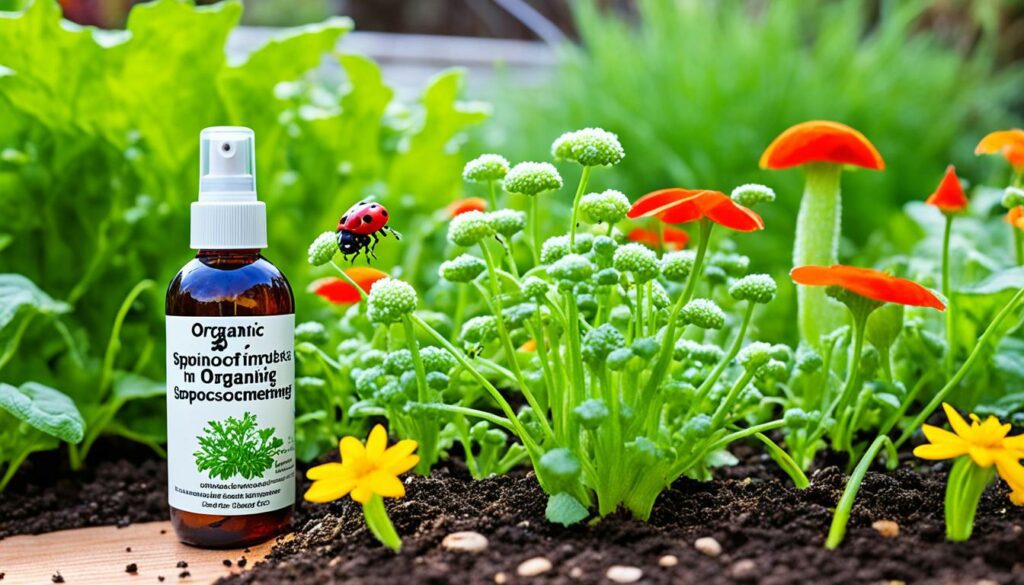
Spinosad is great at handling chewing bugs. It keeps working for a month after you put it on, unless water washes it away. Gardeners can choose from a ready-to-use or a concentrated form. The concentrate is mixed with water before use. You can also find it as dust and granules. It fights off leafminers, spider mites, thrips, and more.
Using Spinosad in organic gardening means taking care to protect beneficial bugs like bees. Although Spinosad is only slightly toxic to humans and pets, it can harm bees. When the spray is still wet, it’s most dangerous for them. Try to treat your plants with Spinosad in the early morning or late evening. Bees aren’t as active then, which lowers the risk.
Exploring organic pest control has shown us its many benefits. Using ingredients like neem oil and garlic keeps our environment safe. It protects our families and pets from harm. These methods are made to be safe for everyone.
Conventional pesticides can hurt more than just the pests. They harm other living things and nature. But using organics, we protect the environment. It keeps the balance by not hurting helpful insects. For instance, ladybugs and bees can thrive too.
Organic pest control also fits well with caring for the planet. It improves soil and saves water. This helps our gardens and farms without damaging the environment. By using these methods, we help make our world better for the future.
Wanna learn more about safe and organic pest control? Check out this informative blog post.
Organic pest control includes many approaches. These are cultural, mechanical, physical, and biological ways. They aim to prevent pest problems without harming the environment or using toxic pesticides.
IPM is a smart way to control pests without causing harm to nature. It starts with checking for pest damage and watching how many pests are around. Then, it uses methods that are safe for the environment and us. It always chooses the least harmful solutions first.
Healthy soil helps plants fight off pests. It’s full of tiny organisms that help plants grow strong. These micro-organisms also stop diseases from spreading. So, healthy soil means fewer pests to worry about.
Companion planting and rotating crops are good ways to stop pests. Choosing the right plants for your area also helps. These methods make it hard for pests to find places to live and food to eat.
Using screens or fences and picking off bugs by hand work well. They’re kind to the planet and keep your garden natural. These methods mean you don’t have to use harmful chemicals to control pests.
Some insects are friends to our plants. Ladybirds and mites eat the bugs that harm crops. So, they naturally help keep the pest population down.
Botanical sprays are a good way to keep pests away. They’re safe for us and the planet. Using these sprays keeps your garden healthy and free from dangerous chemicals.
Neem oil comes from neem tree seeds and keeps bugs away. It’s safe for most insects but stops the ones that hurt plants. Neem oil is great for an eco-friendly pest control plan.
Bt is a kind of bacteria that only affects certain insects. It’s a key part of keeping pests away from crops without using dangerous chemicals. But, it has to be used carefully for it to work well.
These oils kill pests by covering their eggs and young ones. But, they must be used the right way to avoid hurting plants. They are a safe choice for keeping your garden free from pests.
Use Spinosad when good bugs are not active, like early morning or evening. This way, it won’t harm friendly insects while controlling the pests that eat your plants. It’s a careful balance for a healthy garden.